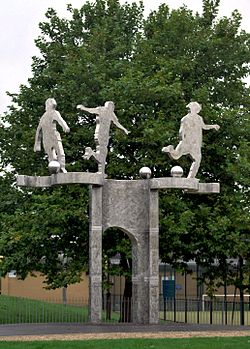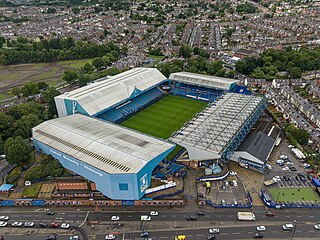
Hillsborough Stadium is a football stadium in Sheffield, England. It has been the home of Sheffield Wednesday since opening in 1899.

Anfield is a football stadium in Anfield, Liverpool, England, which has a seating capacity of 54,074, and is currently under expansion to seat 61,276, which makes it the fifth largest football stadium in England. It has been the home of Liverpool since their formation in 1892. It was originally the home of Everton from 1884 to 1891, before they moved to Goodison Park after a dispute with the club president.

Burton Albion Football Club is a professional association football club in the town of Burton upon Trent, Staffordshire, England. The team compete in League One, the third tier of the English football league system. The club moved its home ground in 2005 to the Pirelli Stadium from Eton Park. The club's nickname, The Brewers, evokes the brewing heritage of Burton upon Trent.

Villa Park is a football stadium in Aston, Birmingham, with a seating capacity of 42,657. It has been the home of Premier League club Aston Villa since 1897. The ground is less than a mile from both Witton and Aston railway stations and has hosted sixteen England internationals at senior level, the first in 1899 and the most recent in 2005. Villa Park has hosted 55 FA Cup semi-finals, more than any other stadium, and it is the 10th largest in England.

Pride Park Stadium is an all-seater football stadium in Derby, England, that is the home ground of English Football League club Derby County. With a capacity of 32,956, it is the 16th-largest football ground in England. Pride Park is a business park on the outskirts of Derby city centre, and the stadium was built as part of the commercial redevelopment of the area in the 1990s. Derby County have played at the ground since it opened in 1997 as a replacement for the Baseball Ground. Due to sponsorship, the venue was officially known as the iPro Stadium between 2013 and 2016.

Old Trafford is a football stadium in Old Trafford, Greater Manchester, England, and the home of Manchester United. With a capacity of 74,310 it is the largest club football stadium in the United Kingdom, and the twelfth-largest in Europe. It is about 0.5 miles (800 m) from Old Trafford Cricket Ground and the adjacent tram stop.

Deepdale is a football stadium in the Deepdale area of Preston, England, the home of Preston North End. Deepdale is "widely recognised as being the oldest 'continuously used' football stadium in the world, though this is contested".

White Hart Lane was a football stadium in Tottenham, North London and the home of Tottenham Hotspur Football Club from 1899 to 2017. Its capacity varied over the years; when changed to all-seater it had a capacity of 36,284. The stadium was fully demolished after the end of the 2016–17 season.
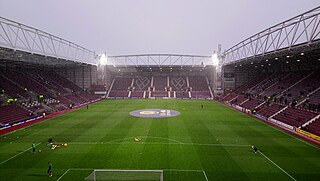
Tynecastle Park, also known as Tynecastle Stadium, is a football stadium in the Gorgie area of Edinburgh, which is the home ground of Scottish Professional Football League club Heart of Midlothian (Hearts). A UEFA category four stadium, it has also hosted Scotland international matches, and been used as a neutral venue for Scottish Cup and Scottish League Cup semi-finals.
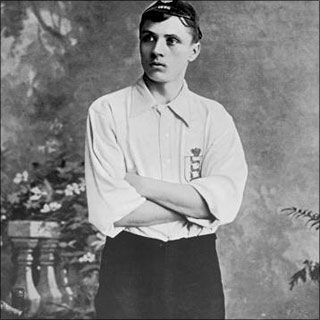
StephenBloomer was an England international footballer and manager who played for Derby County – becoming their record goalscorer – and Middlesbrough. The anthem "Steve Bloomer's Watchin'" is played at every Derby home game and there is a bust of him at the Pride Park Stadium. He is also listed in the Football League 100 Legends and English Football Hall of Fame.

St Andrew's is an association football stadium in the Bordesley district of Birmingham, England. It has been the home ground of Birmingham City Football Club for more than a century. From 2018 to 2021, it was known for sponsorship reasons as St Andrew's Trillion Trophy Stadium.
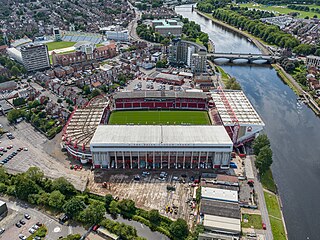
The City Ground is a football stadium in West Bridgford, Nottinghamshire, England, on the banks of the River Trent. It has been home to Nottingham Forest since 1898 and has a capacity of 30,455.

Turf Moor is an association football stadium in Burnley, Lancashire, England, which has been the home of Burnley Football Club since 1883. This unbroken service makes Turf Moor the second-longest continuously used ground in English professional football. The stadium is situated on Harry Potts Way, named after the manager who won the 1959–60 First Division with the club, and has a capacity of 21,944.
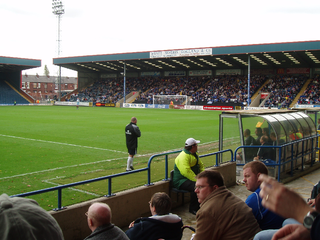
Spotland Stadium, known as the Crown Oil Arena for sponsorship reasons, is a multi-purpose sports stadium in the Spotland area of Rochdale, Greater Manchester which is home to Rochdale A.F.C. and Rochdale Hornets R.F.L.C. The venue has a capacity of 10,249.

The County Ground is a stadium located near the town centre of Swindon, Wiltshire, England, and has been home to Swindon Town Football Club since 1896. The current capacity of 15,728, all-seated, has been at that level since the mid-1990s. A record attendance of 32,000 was set on 15 January 1972, against Arsenal in the third round of the FA Cup. North of the football stadium is Swindon Cricket Club, with their pitch also named The County Ground following its use by the football club from 1893 until 1896.
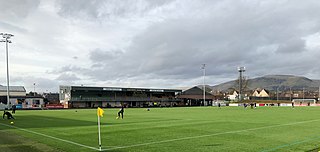
Recreation Park, also known as Recreation Grounds, The Recs and The Indodrill Stadium for sponsorship reasons, is a football stadium in Alloa, Clackmannanshire, Scotland. It is the home ground of Scottish Professional Football League team Alloa Athletic, who have played there since 1895. Additionally, Broomhill of the Scottish Lowland Football League have been groundsharing at Recreation Park since 2016. Central Girls Football Academy have used the stadium for home matches from 2017. The stadium has an artificial playing surface and has a capacity of 3,100.
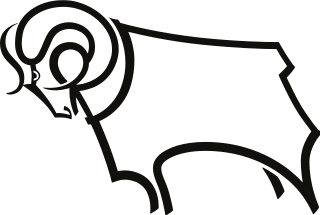
Derby County Football Club is a professional football club in Derby, England, which competes in League One, the third level of the English football league system. Notable for being one of the 12 founder members of the Football League in 1888, Derby County is one of only 10 clubs to have competed in every season of the English football league system, with all but six of those being in the top two divisions.

Pirelli Stadium is an association football stadium on Princess Way in Burton upon Trent, Staffordshire, England. It was built in 2005 and is the current home of Burton Albion FC, replacing the club's old Eton Park home, also on Princess Way, which was demolished and developed into housing. The ground was built on the former site of the Pirelli UK Tyres Ltd Sports & Social Club, and having had the land donated to the club by Pirelli, in return for naming rights, the ground cost £7.2 million to build.
Derby Baseball Club is a defunct professional baseball club from Derby England, formed as Ley's Recreation Club by Francis Ley in 1890 and dissolved in the same year. A new Derby Baseball Club was formed in 1890 to succeed his dissolved club, this new Derby Baseball Club played until 1900, winning numerous National League titles in the 1890s, albeit as amateurs.
Football matches held between Derby County F.C. and Nottingham Forest F.C. are often referred to as an 'East Midlands Derby' and are the focus of a lengthy and intense rivalry. According to an unofficial survey on 'football rivalries' the 'East Midlands Derby' is the sixth fiercest rivalry in English football, with 9 out of 10 fans from the two clubs naming the other as their "fiercest rival".
